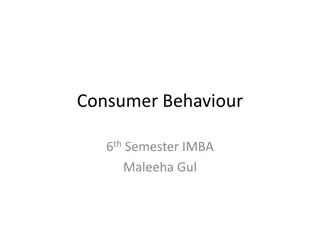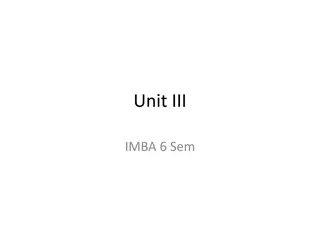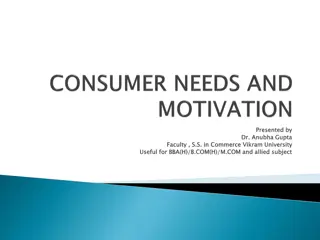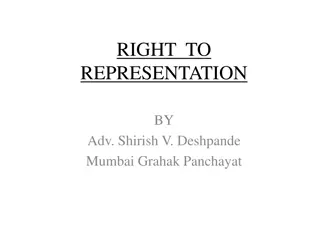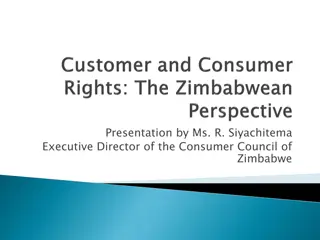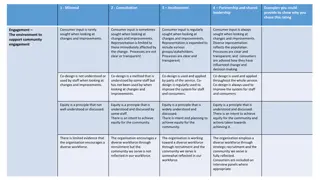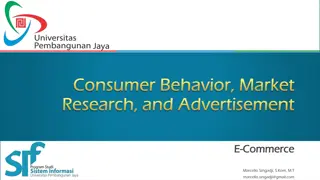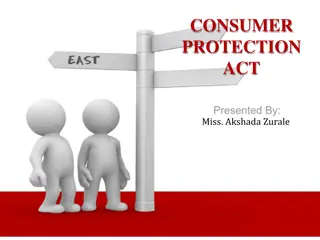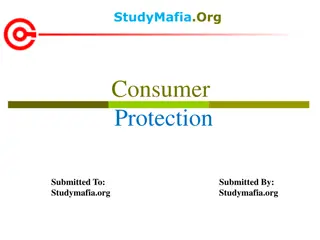Understanding Consumer Behavior: A Comprehensive Overview
Consumer behavior is a vital aspect of marketing, focusing on the intricate patterns and motivations behind consumer decisions. This interdisciplinary subject delves into the cognitive, affective, and behavioral processes that drive individuals or organizations to search for, select, use, and dispose of products or services to meet their needs. By studying consumer behavior, firms can enhance their product offerings, surpass competitors, and thrive in the marketplace.
Download Presentation

Please find below an Image/Link to download the presentation.
The content on the website is provided AS IS for your information and personal use only. It may not be sold, licensed, or shared on other websites without obtaining consent from the author. Download presentation by click this link. If you encounter any issues during the download, it is possible that the publisher has removed the file from their server.
E N D
Presentation Transcript
Consumer Behavior Introduction -1 By: Dr. Shweta Patil Rajale
Introduction Customers are unique in themselves They have needs & wants which are varied & diverse from one another They have different consumption consumption behavior The marketer helps satisfy these needs & wants through product & service offerings For a firm to survive, it is essential that the marketer provides product offerings efficiently than other competitors A comprehensive yet meticulous knowledge of consumers & their consumption behavior is essential for a firm to succeed Consumer Behavior is an interdisciplinary subject patterns & more effectively &
Definition It is broadly the study of individuals, or organizations and the processes consumers use to search, select, use and dispose of products, services, experience, or ideas to satisfy needs and study of its impact on the consumer and society. Those activities directly involved in obtaining , consuming and disposing of products and services, including the decision processes that precede and follow these actions Those actions directly involved in obtaining, consuming and disposing of products and services including the decision processes that precede and follow these actions . -Engel, Blackwell, Miniard
Continued Consumer behavior explains the reasons and logic that underlie purchasing decisions and consumption patterns; it explains the processes through decisions. The study includes within its purview, the interplay between cognition, affect and behavior that goes on within a consumer during the consumption process: selecting, using and disposing off goods and services. which buyers make
Cognition: knowledge, information processing and thinking part; It includes the mental processes involved in processing of information, interpretation of stimuli i.e. product or service or brand offering; Affect: This is the feelings part. It includes the favorable or unfavorable corresponding emotions towards a stimuli (eg. towards a product or service offering or a brand). These vary in direction, intensity and persistence. This includes within its ambit the thinking and feelings and Behavior: This is the visible part. This could be the purchase activity: to buy or not a buy (again specific to a product or service offering, a brand
Nature of Consumer Behavior The subject deals with issues related to cognition, affect and behavior in consumption behaviors, against the backdrop of individual and environmental determinants. The individual determinants pertain to an individual s internal self and include psychological components like personal motivation and learning and memory, attitudes, personality, and, decision making. The environmental determinants pertain to external influences surrounding an sociological, anthropological components like the family, social groups, reference groups, social class, culture, sub-culture, cross-culture, and national and regional influences. involvement, perception, self-concept and individual and include economic and
Continued. The subject is interdisciplinary. It has borrowed heavily from psychology (the study of the individual: individual determinants in buying behavior), sociology (the study of groups: group dynamics in buying behavior), social psychology (the study of how an individual operates in group and its effects on buying behavior), anthropology (the influence of society on the individual: cultural and cross-cultural issues in buying behavior), and economics (income and purchasing power). Consumer behavior involves the process of exchange between the buyer and the seller, mutually beneficial for both. It is a science as well as an art. It uses both, theories borrowed from social consumption behavior, and quantitative and qualitative tools and techniques to predict consumer behavior. sciences to understand
Scope of Consumer Behavior study of consumer understanding consumption behavior. It includes within its ambit the answers to the following: - What the consumers buy: goods and services - Why they buy it: (need and want ) - When do they buy it: (time: day, week, month, year, occasions etc.) - Where they buy it: (place) - How often they buy it: (time interval ) - How often they use it: (frequency of use) The scope of consumer behavior includes not only the actual buyer but also the various roles played by him/ different individuals. The behavior deals with and patterns
Basic Components of C. B. Decision making : this includes the stages of decision making: Need recognition, Information search, Evaluation of activity, Post purchase behavior. Actual purchase (Behavior): visible physical activity of buying of goods and/or service. It is the result of the interplay of many individual and environmental determinants which are invisible. Individual determinants influences: The environmental factors affect the decision process indirectly, affecting individual determinants alternatives, Purchase -this includes the and environmental through way of
Continued Buying roles: There are five buying roles, viz., Initiator, Influencer, Decider, User, Buyer. The initiator is the person who identifies that there exists a need or want; the influencer is the one who influences the purchase decision, the actual purchase activity and/or the use of the product or service; the decider is the one who decides whether to buy, what to buy, when from where to buy, and how to buy; the buyer is the one who makes the actual purchase; and, the user is the person (s) who use the product or service. These five roles may be played by one person or by different persons. A person may assume one or more of these roles. Actual Buyer vis a vis other users. to buy,
Continued Example 1: A child goes to a kindergarten school. She comes back home and asks her parents to buy her a set of color pencils and crayons. Now the roles played are: 1. Initiator: the child in nursery school 2. Influencer: a fellow classmate 3. Decider: the father or the mother 4. Buyer: the father or the mother 5. User: the child Example 2: The lady of a house who is a housewife and spends her day at home doing household chores watches TV in her free time. That is her only source of entertainment. The TV at home is giving problem. She desires a new TV set, and says that she wants an LCD plasma TV. Now the roles played are: 1. Initiator: the housewife (mother) 2. Influencer: a friend / neighbour 3. Decider: the husband or the son 4. Buyer: the husband or the son 5. User: the family



